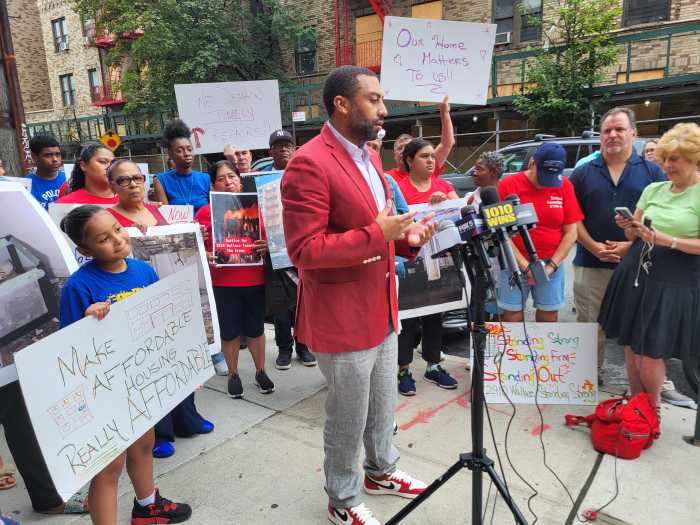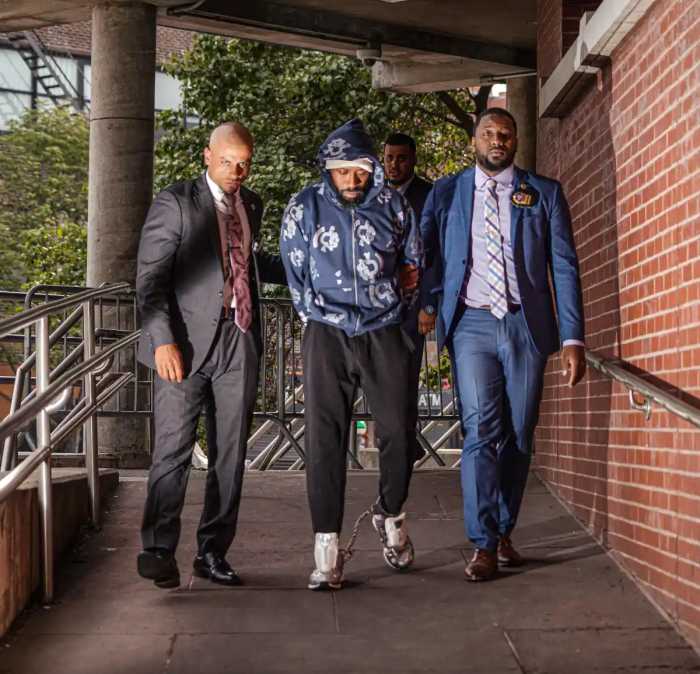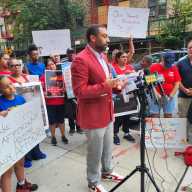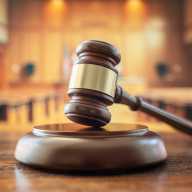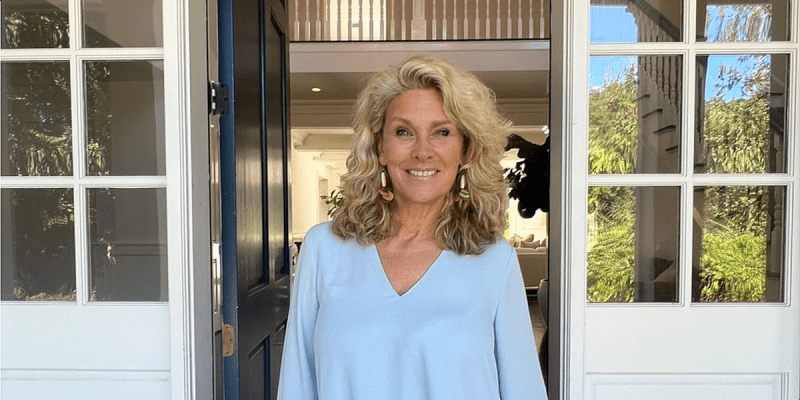“Jesus is coming for us!” Bronx Borough President Vanessa Gibson said on social media after Friday morning’s earthquake rattled New York City. “That was crazy!!!!”
At around 10:30 a.m. on April 5, a 4.8 magnitude earthquake centered near Whitehouse Station, New Jersey, caused shaking throughout the Bronx and New York City. Since 1950, there have been 40 other quakes magnitude 3 or higher within approximately 155 miles of the epicenter of today’s rumble, the U.S. Geological Survey (USGS) reported — however this one was the largest recorded in that timeframe.
Lord have mercy! I just felt my office shake in my building. Jesus is coming for us! Oh dear. Praying that everyone is safe! That was crazy!!!! 🙏🙏
— Hon. Vanessa L. Gibson, MPA (She, Her, Hers) (@Vanessalgibson) April 5, 2024
John Doyle, president of the nonprofit City Island Rising, told the Bronx Times via text message that the quake on the island in the East Bronx was a “wild experience.” He’s 38 years old, and said the earthquake was the first he’s felt in his lifetime.
“I was home in my apartment and everything started shaking,” he said. “At first I thought it was something local (there’s a house two doors down being fully reconstructed) but by the time I got outside I realized it was an earthquake.”
Doyle said “everyone” in the coffee shop he went to after the EQ was talking about it.
Bronx resident Armando “AJ” Ramos told the Bronx Times that he felt the tremor in Norwood near the Mosholu Parkway Fault and that others he spoke to in the area were “scared this might just be the start of the quakes.” In a 2008 study by Columbia University, the Mosholu Fault was listed as a potentially hazardous spot for earthquakes in New York City. Officials have forecasted a “low likelihood” of aftershocks, but some were apparently felt in Manhattan and Brooklyn around 6 p.m. on April 5, according to officials. They’re still waiting on final USGS confirmation.
A North Riverdale resident wrote in to the Bronx Times from a high rise.
“Was sitting having my coffee and felt as if there might have been an explosion in one of the apartments on a lower floor of the building,” the resident said. “Realized it was not, as it lasted more than 10 seconds!”
Another said they were “sitting at my computer, and I felt the wall shake and it frightened me.”
The Bronx Times confirmed that people far and wide felt the quake this morning — from Philadelphia and New Jersey to New York City and even all the way up to Rockland County north of the city.
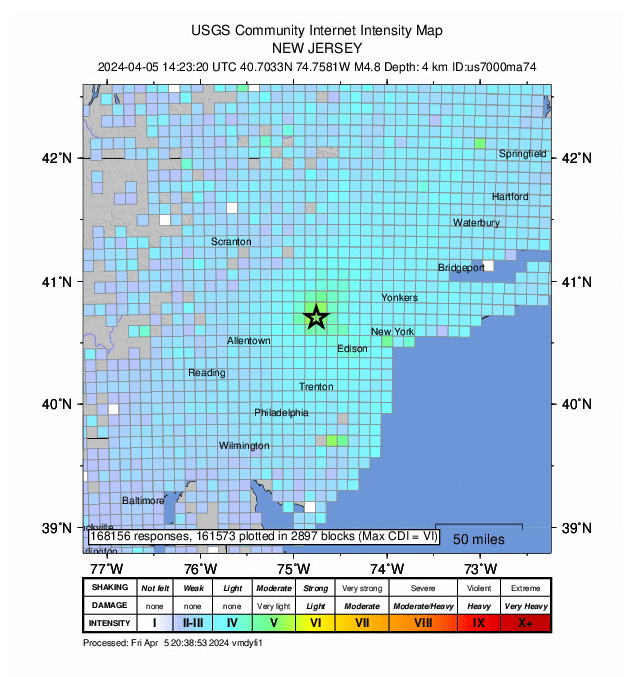
Fordham University’s seismic observatory center in the Bronx captured the tremor on April 5, the school said. In the report, Stephen Holler, a physics professor who leads the station, said the EQ was “a very short and very quick event compared to some of the others that we’ve seen where it seems like it kind of rings for a long time.”
According to USGS, severe temblors have been felt in the eastern United States, and earthquakes of the same magnitude often affect the East and West differently.
For example, a 2011 magnitude 5.8 tremor in Mineral, Virginia was felt up to 600 miles from the epicenter and caused a lot of damage, but a 2014 6.0 shake in Napa, California was only felt at a maximum of 250 miles from its center. Some of the factors that could contribute to the phenomenon have to do with the differences in “underlying tectonic plates and their geologic history,” according to USGS, and others are “connected to the size and age of buildings.”
USGS reported that the April 5 quake “occurred in a region where faults have been previously identified and may be reactivated at any time.”
But still, EQs are less frequent on the East Coast than out west — most likely a factor contributing to the buzz floating around the Bronx and entire city on April 5.
Here’s how social media reacted to New York City’s earthquake
Barbara Dolensek, vice president of the City Island Historical Association and a writer for the Island Current publication, told the Bronx Times that the earthquake was “nothing to get excited about” on April 5.
“No furniture in my house moved; my dogs paid no attention,” she said. “Nearly every day the firing range at Rodman’s Neck makes more of an impact on City Island than this minor event.”
In a press briefing from the city’s Office of Emergency Management headquarters in Brooklyn on April 5, officials — including representatives from the Department of Education, Con Edison gas, the MTA and city immigrant service agencies — said they hadn’t seen reports of any damage.
They encouraged the public to assess their own buildings and report any damage they might find, emphasizing that they’ve mobilized for additional emergency response through the weekend. To report to the city dial 311, and to report to USGS, answer the survey at: earthquake.usgs.gov/data/dyfi. For an emergency, dial 911.
New York City Schools Chancellor David Banks said at the briefing that no student injuries had been reported, and that parents shouldn’t pick their kids up early. Additionally, he said after school events are proceeding as scheduled. Similarly, MTA officials said as of 12:25 p.m. there have been no abnormal delays or changes to public transportation as a result of the earthquake.
Cell phone service was interrupted on April 5, most likely due to too many calls going through at once. New Yorkers took to social media to react to the earthquake, noting that an emergency alert came about 20 minutes after the actual incident. Zach Iscol, the commissioner of New York City Emergency Management, however, said at the briefing said 20 minutes was a quick alert time.
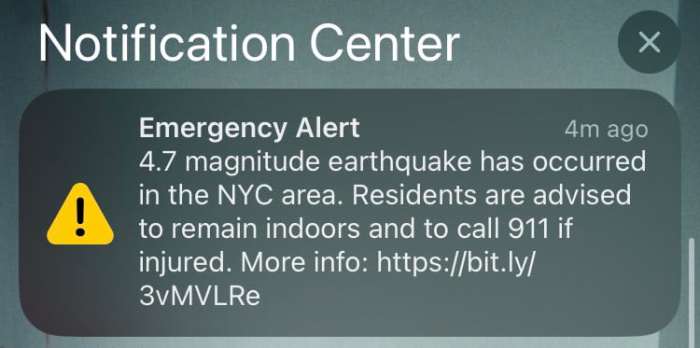
New York City Mayor Eric Adams reported no major infrastructure damage or injuries related to the earthquake at the press conference and also told New Yorkers to drop to the floor and cover backs and necks if there are aftershocks. He advised New Yorkers to “go about their normal day.”
He said his administration is in touch with the White House, the governor’s office and local elected officials. He also encouraged New Yorkers to check on their loved ones.
“Earthquakes don’t happen every day in New York,” Adams said. “This can be extremely traumatic the number of texts, calls and inquires people sent out not only to our administration but to family members checking on them, we know how this can impact you.”
This story was last updated at 6:16 p.m. on April 5.
Another version of this story was originally published by our affiliate amNewYorkMetro. Additional reporting was done by Emily Davenport, Ethan Stark-Miller, Robert Pozarycki, Zach Gewelb and Barbara Russo.
Reach Camille Botello at cbotello@schnepsmedia.com. For more coverage, follow us on Twitter, Facebook and Instagram @bronxtimes




